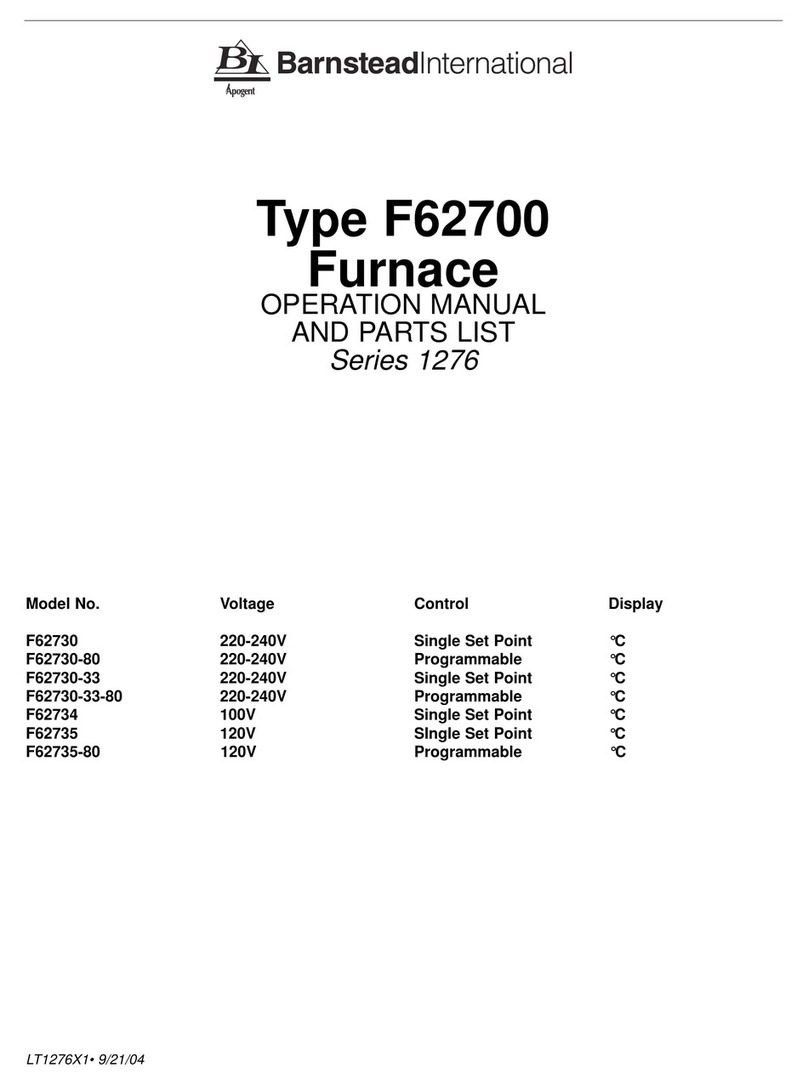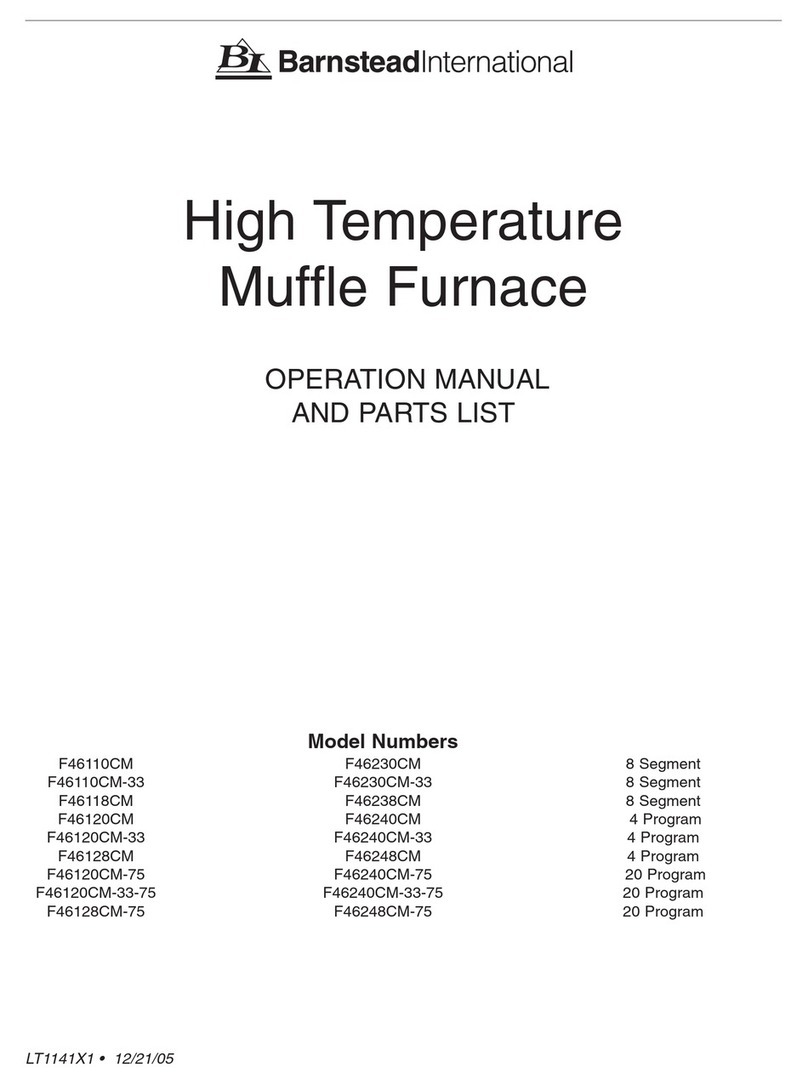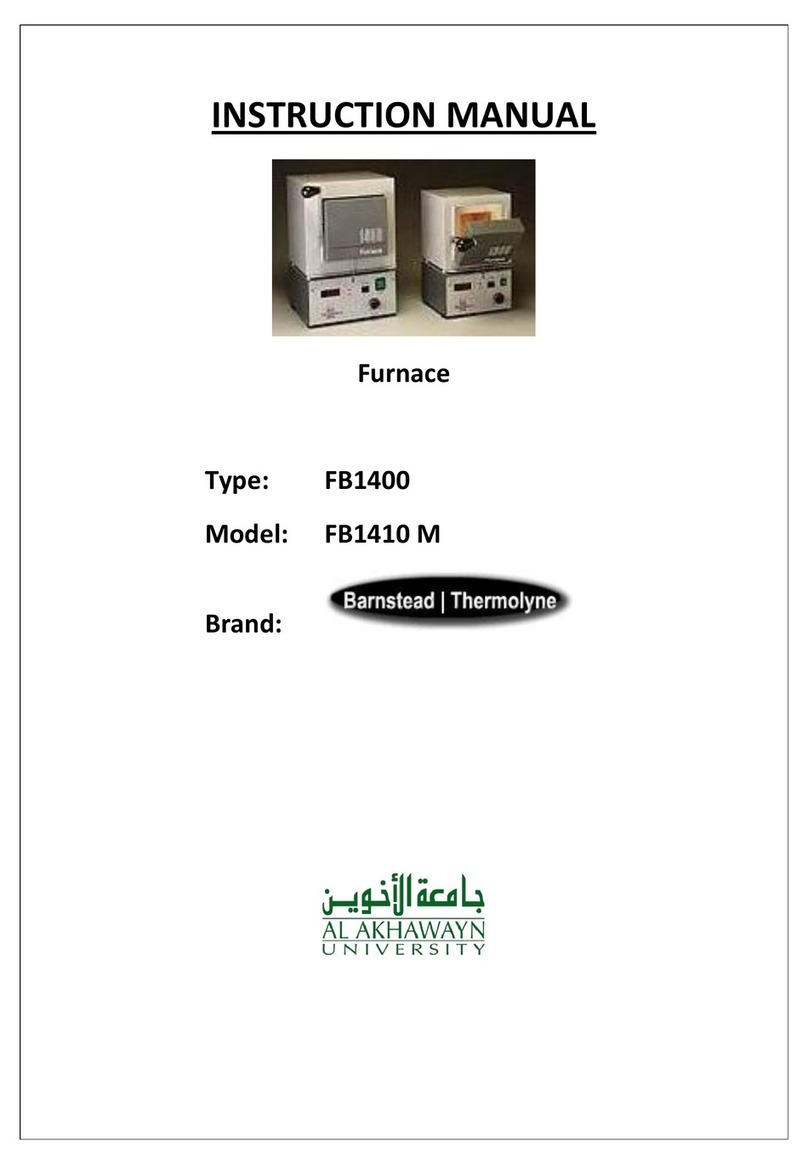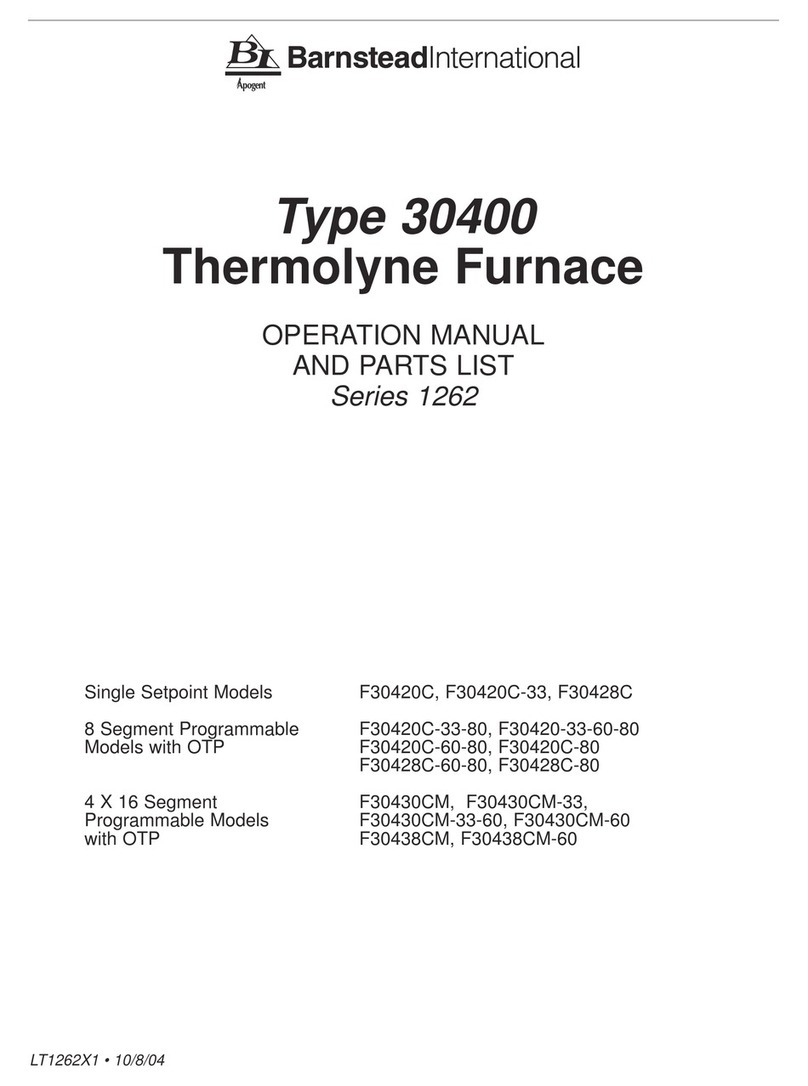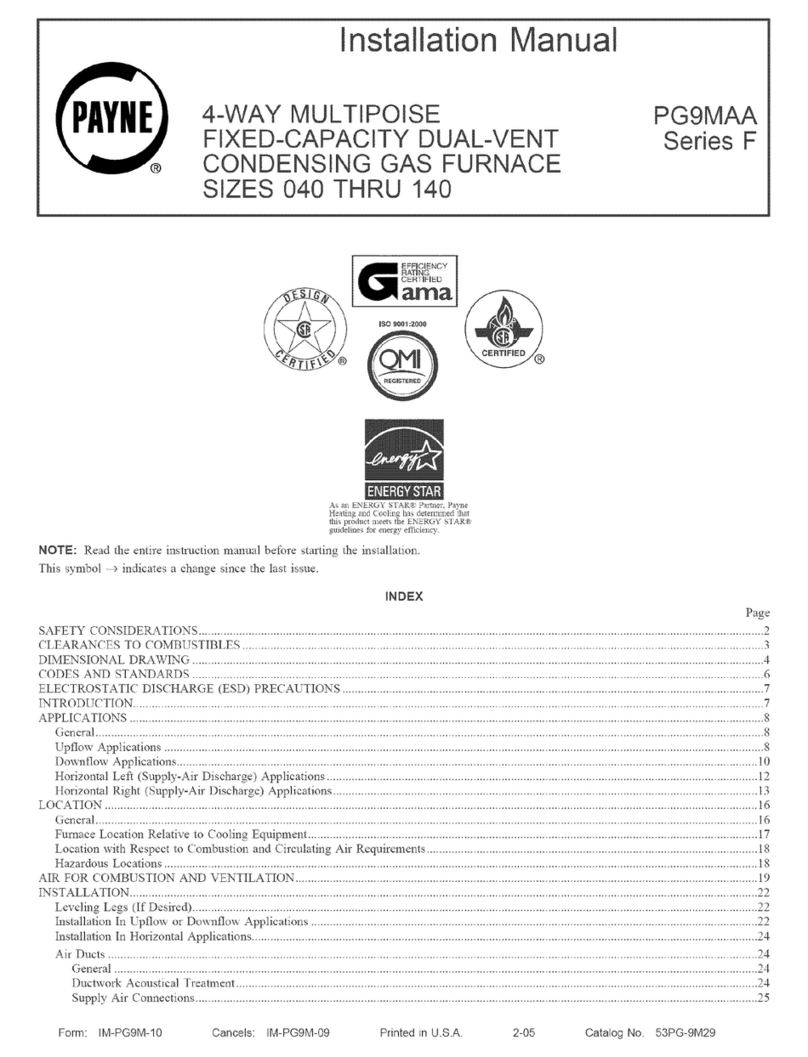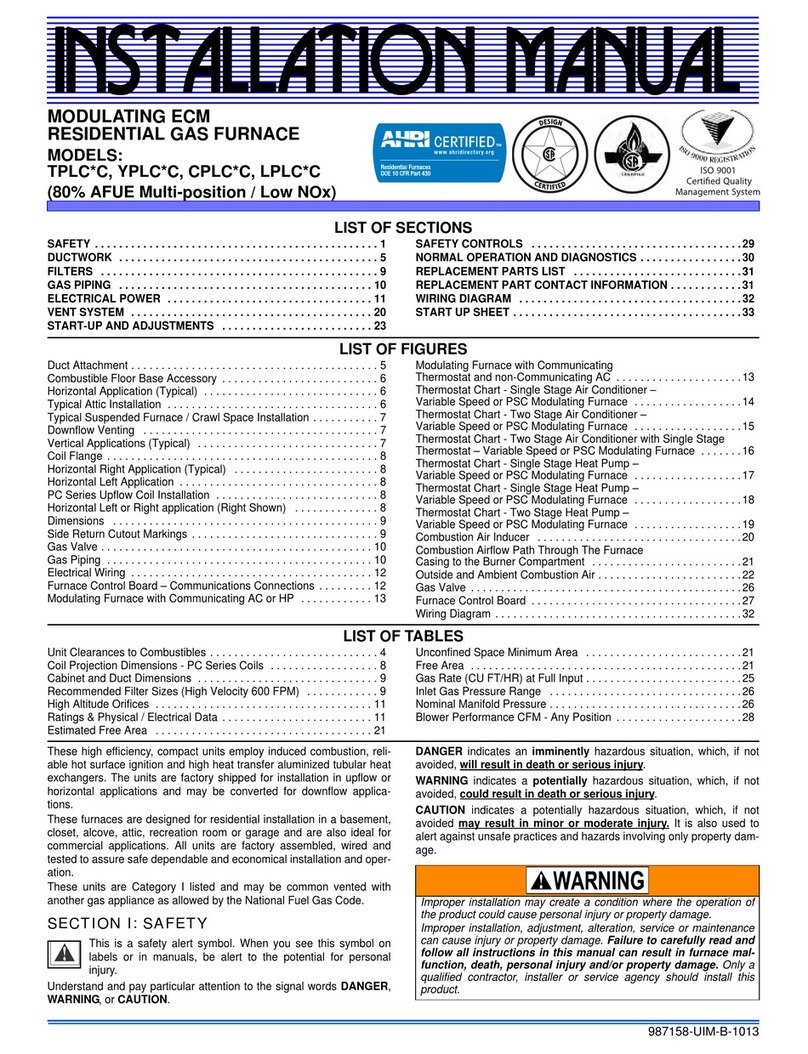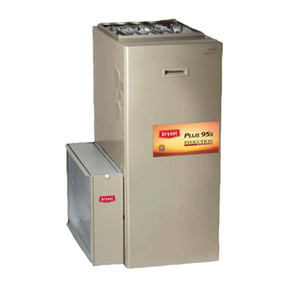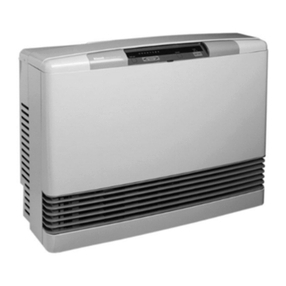Barnstead F46110CM User manual

1
BARNSTEAD|THERMOLYNE CORPORATION
High Temperature
Muffle Furnace
OPERATION MANUAL
AND PARTS LIST
Model Numbers
F46110CM F46230CM Automatic
F46110CM-33 F46230CM-33 Automatic
F46118CM F46238CM Automatic
F46120CM F46240CM Multi-Programmable
F46120CM-33 F46240CM-33 Multi-Programmable
F46128CM F46248CM Multi-Programmable
F46120CM-75 F46240CM-75 Multi-Programmable
F46120CM-33-75 F46240CM-33-75 Multi-Programmable
F46128CM-75 F46248CM-75 Multi-Programmable
LT1078X2 • 5/9/97

2
IMPORTANT INFORMATION
This manual contains important operating and safety information.The user must carefully read and understand
the contents of this manual prior to the use of this equipment.
Table of Contents
Safety Information ..........................................................................................................................................4
Alert Boxes.....................................................................................................................................................4
Warnings ........................................................................................................................................................5
Description .....................................................................................................................................................7
Intended Use .............................................................................................................................................7
General Usage ......................................................................................................................................... 7
Principles of Operation ..............................................................................................................................7
Types of Controllers.................................................................................................................................. 8
General Specifications ...................................................................................................................................9
General Specifications .................................................................................................................................10
Environmental Conditions........................................................................................................................10
Declaration of Conformity ........................................................................................................................11
Unpacking ....................................................................................................................................................12
Installation ....................................................................................................................................................13
Furnace Connection ................................................................................................................................13
Initial heat-up procedure:.........................................................................................................................13
General Operation of Furnace......................................................................................................................14
Power Switch...........................................................................................................................................14
Cycle Indicator.........................................................................................................................................14
Circuit Breaker.........................................................................................................................................15
Fans ........................................................................................................................................................15
Controllers ...............................................................................................................................................15
Operation of Automatic Models ....................................................................................................................16
Control Parameters .................................................................................................................................16
Tuning Your Furnace ...............................................................................................................................17
Single Set Point Operation ...................................................................................................................18
Program Ramp Rate................................................................................................................................19
Program Ramp Reset..............................................................................................................................19
Operation of Programmable Models.............................................................................................................20
Control Parameters .................................................................................................................................20
Tuning Your Furnace ...............................................................................................................................22
Operating the Controller ......................................................................................................................... 23
Single Set Point Operation ...................................................................................................................23
Programming Controller ..........................................................................................................................23
Multi-Programmable Controller Program Entry (Models F46120CM,
F46120CM-33, F46120CM-33-75, F46120CM-75, F46128CM, F46128CM-75, F46240CM,
F46240CM-33, F46240CM-33-75, F46240CM-75, F46248CM, F46248CM-75) ..................................24
Program Entry (all models)......................................................................................................................25
Implementing Programs ..............................................................................................................................27
Program Execution ................................................................................................................................. 27
Parameter Change While Running ..........................................................................................................27
Loop Count..............................................................................................................................................27
Program Hold ........................................................................................................................................ 27
Program Reset ....................................................................................................................................... 28
Table of Contents

3
Furnace Loading: .........................................................................................................................................29
FurnaceAtmospheres .............................................................................................................................30
Preventive Maintenance.............................................................................................................................. 31
General Cleaning Instructions ............................................................................................................... 32
Problem Solving Guide.................................................................................................................................33
Maintenance and Servicing ..........................................................................................................................34
Wiring Diagram............................................................................................................................................ 38
Wiring Diagram.............................................................................................................................................39
Wiring Diagram.............................................................................................................................................40
Wiring Diagram.............................................................................................................................................41
Replacement Parts List ............................................................................................................................... 42
Ordering Procedures ....................................................................................................................................43
Material Safety Data Sheet ..........................................................................................................................44
Warranty.......................................................................................................................................................47
TABLE OF CONTENTS

4
Safety Information
Your Thermolyne furnace has been designed with function,
reliability, and safety in mind. It is the user’s responsibility to
install it in conformance with local electrical codes. For safe
operation, please pay attention to the alert boxes through-
out the manual.
Because of the nature of this product, considerably more
care is required in operating and servicing this furnace than
for lower temperature laboratory furnaces. For maximum
safety and longest furnace life, be sure to observe the
various cautions and warnings throughout this manual.
Alert Boxes
WARNING
Warning alerts apply when there is a
possibility of personal injury.
CAUTION
Caution alerts apply when there is a
possibility of
damage to the equipment.
NOTE
Notes alert the manual user to
pertinent facts and
conditions.
HOT SURFACE
Hot surfaces alert you to a possibility
of personal
injury if you come in contact with a
surface during use or for a period of
time after use.
Safety Information

5
WARNING
To avoid electrical shock, this furnace must:
1. Be installed by a competent, qualified electrician who
insures compatibility among furnace specifications,
electrical source and grounding code requirements.
2. Always be disconnected from the electrical supply
prior to maintenance and servicing.
To avoid personal injury:
1. Do not stand directly in front of the chamber without
wearing a heat resistant face shield, gloves and apron.
2. Do not operate or clean furnace without proper eye
protection.
3. Do not use in the presence of flammable or combus-
tible materials; fire or explosion may result.This
device contains components which may ignite such
materials.
4. Refer servicing to qualified personnel.
5. Caution: Hot Surface. Avoid Contact.
6. To AVOID EYE DAMAGE in operating or cleaning
furnace, proper eye protection must be worn.
7. To AVOID BURNS, do not stand directly in front of the
chamber without wearing a heat resistant faceshield,
gloves and apron.
8. To AVOID FIRE, do not place combustible materials
where exposed to heat from open door.
HOT SURFACE
Caution: Hot Surface. Avoid Contact.
SAFETY INFORMATION

6
Please note the following WARNINGS:
WARNING
This warning is presented for compliance with California Proposition 65 and other regulatory agencies and only
applies to the insulation in this product.This product contains refractory ceramic, refractory ceramic fiber or
fiberglass insulation, which can produce respirable dust or fibers during disassembly. Dust or fibers can cause
irritation and can aggravate pre-existing respiratory diseases. Refractory ceramic and refractory ceramic fibers
(after reaching 1000°C) contain crystalline silica, which can cause lung damage (silicosis).The International
Agency for Research on Cancer (IARC) has classified refractory ceramic fiber and fiberglass as possibly
carcinogenic (Group 2B), and crystalline silica as carcinogenic to humans (Group 1).
The insulating materials can be located in the door, the hearth collar, in the chamber of the product or under the
hot plate top.Tests performed by the manufacturer indicate that there is no risk of exposure to dust or respi-
rable fibers resulting from operation of this product under normal conditions. However, there may be a risk of
exposure to respirable dust or fibers when repairing or maintaining the insulating materials, or when otherwise
disturbing them in a manner which causes release of dust or fibers. By using proper handling procedures and
protective equipment you can work safely with these insulating materials and minimize any exposure. Refer to
the appropriate Material Safety Data Sheets (MSDS) fo information regarding proper handling and recom-
mended protective equipment. For additional MSDS copies, or additional information concerning the handling
of refractory ceramic products, please contact the Customer Service Department at Barnstead|Thermolyne
Corporation at 1-800-553-0039.
WARNING
REFER SERVICING TO QUALIFIED PERSONNEL.
SAFETY INFORMATION

7
Intended Use
Types 461 and 462 are general purpose laboratory
furnaces
intended for applications requiring temperatures from
800-1700
degrees C.
General Usage
Do not use this product for anything other than its
intended usage.
Principles of Operation
The chamber section is heated by six (in type F46100
urnaces) or eight (in type F46200 furnaces) Super
Kanthal 33 heating elements suspended in a chamber
made of alumina and silica high temperature refractory
fiber.
This high temperature refractory fiber is in the form of
blocks which line the inside of the chamber. Because of
the
stresses caused by extremely high temperature opera-
tion, these blocks will show some surface cracking.This
cracking is not detrimental to the operation of the fur-
nace.
A precious metal type B thermocouple senses the
temperature in the chamber and transmits this informa-
tion to the temperature control in millivolts.
NOTE
The fans operate continuously, even
when the circuit breaker is OFF, to assure
that the control section and the terminals
of the heating elements are continuously
ventilated. Without ventilation, residual
heat from the furnace chamber can cause
overheating after the furnace is turned off.
CAUTION
Do not completely remove electricity from
the furnace until chamber temperature
falls below 500°C. Do not touch exposed
elements.
Description

8
The control section consists of a temperature controller, a
current controller, a transformer, a contactor (relay), a
circuit breaker, and a pilot light.
The temperature controller senses the furnace temperature
(by means of the thermocouple) and adjusts electricity to
the heating elements by means of the current controller.
The current controller controls electricity to the heating
elements by adjusting the magnitude of the electrical
current (rather than turning the electricity completely on or
off).This is the preferred method of controlling electricity to
molybdenum disilicide heating elements.
The transformer supplies the proper electrical voltage to the
heating elements.
The contactor removes electricity from the heating elements
if the furnace temperature equals or exceeds the high limit
set point of the controller
The circuit breaker is used to turn the furnace on and off
and also protects the electrical supply in the event that the
furnace draws too much electrical current.
The pilot light indicates that the circuit breaker is ON and
that the controller is being supplied with electricity.
A fan is provided in each section of the furnace to provide
forced air cooling.
Types of Controllers
1. The automatic (single set point) digital model enables the
user to program a single set point temperature which the
furnace will heat and hold.
2. The 4 program, programmable digital model enables the
operator to program up to 8 ramp segments (heat-up or
cool-down rate) and 8 dwell segments (soak) for applica-
tions that require time and temperature relationship for
up to 4 separate or linkable programs.
3. The 15 program, programmable digital model enables
the operator to program up to 8 ramp segments (heat-up
or cool-down rate) and 8 dwell segments (soak) for up to
15 separate or linkable programs.
DESCRIPTION

9
General Specifications
Model# F46110CM, F46118 F46120CM F46128 F46120CM-75 F46128CM-75
F46110CM-33 F46120CM,-33 F46120CM-33-75
Dimensions Overall-in Width 28-1/8 28-1/8 28-1/8 28-1/8 28-1/8 28-1/8
(cm) (71.4) (71.4) (71.4) (71.4) (71.4) (71.4)
Height 18-1/2 18-1/2 18-1/2 18-1/2 18-1/2 18-1/2
(47) (47) (47) (47) (47) (47)
Depth 19 19 19 19 19 19
(48.3 (48.3) (48.3) (48.3) (48.3 (48.3)
Chamber- Width 6 6 6 6 6 6
in (cm) (15.2) (15.2) (15.2) (15.2) (15.2) (15.2)
Height 6-1/2 6-1/2 6-1/2 6-1/2 6-1/2 6-1/2
(16.5) (16.5) (16.5) (16.5) (16.5) (16.5)
Depth 6-1/4 6-1/4 6-1/4 6-1/4 6-1/4 6-1/4
(15.9) (15.9) (15.9) (15.9) (15.9) (15.9)
Weight LBS.(kg) 156 (70.9) 156 (70.9) 156 (70.9) 156 (70.9) 156 (70.9) 156(70.
Electrical Volts 240 208 240 208 240 208
Rating Amps 40*/10.4# 40*/12# 40*/10.4# 40*/12# 40*/10.4# 40*/12#
Watts 9600* 8320* 9600* 8320* 9600* 8320*
2500# 2500# 2500# 2500# 2500# 2500#
Phase 1 1 1 1 1 1
Temp. Range Cont. 1700°C 1700°C 1700°C 1700°C 1700°C 1700°C
Controller Automatic Automatic 4-Program. 4-Program. Multi-Prog. Multi-Prog.
NOTES:*Inrush power and current.
# Power and current required to maintain maximum temperature after stabilization.
The maximum current is determined by the limiting factor set by the current controller.In the event that 40 amperes is not available, the
current controller may be set to limit the current to some smaller value at the expense of a somewhat longer heat-up time.
The variation in current is a result of molybdenum disilicide heating elements
having a large decrease in resistance with increasing temperature.
NOTES:The maximum ramp rates for this furnace for heat-up are: 100°C per minute from 25°C-1000°C and
15°C per minute from 1000°C-1700°C.
General Specifications

10
Model# F46230CM, F46238 F46240CM F46248 F46240CM-75 F46248CM-75
F46230CM-33 F46240CM,-33 F46240CM-33-75
Dimensions Overall-in Width 34-1/8 34-1/8 34-1/8 34-1/8 34-1/8 34-1/8
(cm) (86.7) (86.7) (86.7) (86.7) (86.7) (86.7)
Height 22-1/2 22-1/2 22-1/2 22-1/2 22-1/2 22-1/2
(57.2) (57.2) (57.2) (57.2) (57.2) (57.2)
Depth 23 23 23 23 23 23
(58.4) (58.4) (58.4) (58.4) (58.4) (58.4)
Chamber- Width 10 10 10 10 10 10
in (cm) (25.4) (25.4) (25.4) (25.4) (25.4) (25.4)
Height 10-1/4 10-1/4 10-1/4 10-1/4 10-1/4 10-1/4
(26) (26) (26) (26) (26) (26)
Depth 9-3/4 9-3/4 9-3/4 9-3/4 9-3/4 9-3/4
(24.8) (24.8) (24.8) (24.8) (24.8) (24.8)
Weight LBS.(kg) 234 (106.3) 234 (106.3) 234 (106.3) 234 (106.3) 234 (106.3) 234 (106.3)
Electrical Volts 240 208 240 208 240 208
Rating Amps 40*/20.8# 40*/24# 40*/20.8# 40*/24# 40*/20.8# 40*/24#
Watts 9600* 8320* 9600* 8320* 9600* 8320*
5000# 5000# 5000# 5000# 5000# 5000#
Phase 1 1 1 1 1 1
Temp. Range Cont. 1700°C 1700°C 1700°C 1700°C 1700°C 1700°C
Controller Automatic Automatic 4-Program. 4-Program. Multi-Prog. Multi-Prog.
# Power and current required to maintain maximum temperature after stabilization.
The maximum current is determined by the limiting factor set by the current controller.In the event that 40 amperes is not available, the
current controller may be set to limit the current to some smaller value at the expense of a somewhat longer heat-up time.
The variation in current is a result of molybdenum disilicide heating elements
having a large decrease in resistance with increasing temperature.
NOTES:The maximum ramp rates for this furnace for heat-up are: 100°C per minute from 25°C-1000°C and
15°C per minute from 1000°C-1700°C.
Environmental Conditions
Operating:17°C-27°C; 20% to 80% relative humidity,
non-condensing. Installation Category II (over- voltage) in accordance with IEC 664.
Pollution Degree 2 in accordance with IEC 664. Altitude limit: 2,000
meters.
Storage: -25°C to 65°C; 20% to 80% relative humidity.
GENERAL SPECIFICATIONS

11
Declaration of Conformity
(-33 models only)
Barnstead|Thermolyne hereby declares under its sole
responsibility that this product conforms with the techni-
cal requirements of the following standards:
EMC: EN 50081-1 Generic Emission Standard;
EN 50082-1 Generic Immunity Standard;
Safety: IEC 1010-1-92 Safety requirements for
electrical equipment for measurement,
control, and laboratory use; Part I:
General Requirements
IEC 1010-2-010 Part II: Particular
requirements for laboratory equipment
for the heating of materials
per the provisions of the Electromagnetic Compatability
Directive 89/336/EEC, as amended by 92/31/EEC and
93/68/EEC, and per the provisions of the Low Voltage
Directive 73/23/EEC, as amended by 93/68/EEC.
The authorized representative located within the Euro-
pean Community is:
European Manager
Barnstead|Thermolyne
Saarbrückener Str. 248
D-38116 Braunschweig
Germany
Copies of the Declaration of Conformity are available
upon request.
NOTE
The Type 46100 and 46200 furnaces do
not come with an electrical cord because
current requirements are too great to be
handled by ordinary electrical cords and
standard wall electrical outlets.
Declaration of Conformity

12
Unpacking
Visually check for any physical damage to the shipping
container. Inspect the equipment surfaces that are adjacent
to any damaged area. Open the furnace door and remove
packing material from inside the furnace chamber.Vacuum
the chamber prior to use to remove the insulation dust due
to shipment. A hearth plate is supplied with the furnace to
be placed on bottom of furnace chamber.
Retain the original packaging material if re-shipment is
foreseen or required.
CAUTION
Be sure ambient temperature does
not exceed 104°F (40°C). Ambient
temperatures above 104°F (40°C)
may result in damage to the controller.
Allow at least six inches (15 cm) of
space between the furnace on all
sides and the top.This permits the
heat from the furnace case to escape.
WARNING
To avoid electrical shock, this furnace
must be installed by a competent,
qualified electrician who insures
compatibility among furnace specifi-
cations, electrical source and ground-
ing code requirements. Ensure unit is
properly grounded.
CAUTION
For supply connections, use 8 AWG or
larger wires suitable for at least 90°C.
Failure to observe this caution could
result in damage to furnace.
Unpacking

13
Installation
Site Selection: Install furnace on a sturdy surface and
allow space for ventilation.
The electrical specifications are located on the specifica-
tion
plate on the back of the furnace. Consult Barnstead/
Thermolyne if your electrical service is different than
those listed on the specification plate. Prior to connecting
your Type 46100 or 46200 furnace to your electrical
supply, be sure the front circuit breaker is in the OFF
position.
Furnace Connection
Remove cover plate for access to the electrical connec-
tions. Connect electricity to the three terminals found
behind this plate; one side of the 208 or 240 volt service
to the top terminal, L1; the other side of the 208 or 240
volt service to the bottom terminal, L2, and the ground
(usually green wire) to the center terminal marked GND.
For 220 volt service,connect the neutral to the top
terminal (marked L1); the 220 volt line to the bottom
terminal, L2, and the ground to the center terminal
marked GND. Electricity must be brought to the furnace
through an appropriate conduit system, through the hole
in the back panel at the bottom left rear of the furnace,
and connected as described. Be sure to observe local
wiring codes in connecting.
Initial heat-up procedure:
The elements may bend slightly sideways due to electro-
magnetic forces generated between the element shanks.
To prevent this bending, heat the furnace up to 1650°C
for 10-20 minutes.Then let furnace cool to ambient
temperature. See Operation for your particular controller
for information on setting temperature setpoints.
Installation

14
General Operation of Furnace
Observe these Warnings before operating your furnace:
WARNING
To avoid electrical shock, this furnace must:
1. Be installed by a competent, qualified electrician who
insures compatibility among furnace specifications, electri-
cal source and grounding code requirements.
2. Always be disconnected from the electrical supply
prior to maintenance and servicing.
To avoid personal injury:
1. Do not stand directly in front of the chamber without
wearing a heat resistant faceshield, gloves and apron.
2. Do not operate or clean furnace without proper eye
protection.
3. Do not use in the presence of flammable or combustible
materials; fire or explosion may result. This device contains
components which may ignite such materials.
4. Refer servicing to qualified personnel.
5. Caution: Hot Surface. Avoid Contact.
6. To AVOID EYE DAMAGE in operating or cleaning
furnace, proper eye protection must be worn.
7. To AVOID BURNS, do not stand directly in front of the
chamber without wearing a heat resistant faceshield, gloves
and apron.
8. To AVOID FIRE, do not place combustible materials
where exposed to heat from open door.
HOT SURFACE
Caution: Hot Surface. Avoid Contact.
Power Switch
Controls power to the furnace. Switch to the “ON” position
to energize the elements and the controller.
Cycle Indicator
The amber cycle light will illuminate when electricity is
being supplied to the elements.
CAUTION
Remember that when the power switch
is turned “ON”, the furnace will begin to
heat to the set point temperature that
was previously set in the controller. This
value will remain unchanged for up to a
year without electricity being supplied to
the controller.
CAUTION
If the electrical supply must be discon-
nected from the furnace at any time, be
sure the chamber temperature is 500°C
or less before doing so.
General Operation of Furnace

15
Circuit Breaker
A double pole circuit breaker is located at the bottom of
the control section. It serves to turn electricity ON and
OFF and to protect the electrical circuit.
Fans
The fans, located in the rear of the heating section and
the control section, will run continuously as long as
electricity is supplied to the furnace, even when the
furnace panel circuit breaker is OFF.This serves to
remove residual heat after the furnace is turned OFF so
the heat does not cause damage to the controls.
Controllers
Your furnace’s controller consists of a microprocessor
based three-mode (Proportional, Integral, Derivative),
programmablecontrol with overtemperature protection
and appropriate output switching devices to control the
furnace.The digital readout continuously displays
chamber (upper display) and set point (lower display)
temperatures unless the scroll button is depressed.
If the scroll button is depressed and released, the lower
display will indicate output power (OP) or set point (SP).
This is referred to as the “short scroll”. Continued single
step depression of scroll button will cause lower display
to alternate between set point (SP) and output power
(OP).
To enter the main scroll list (list of all controller param-
eters that are accessed through front keyboard), the
scroll button should be held depressed.On the Automatic
Models, PR (program ramp rate) will appear. On the
Programmable Models, PR1 (program ramp rate 1) will
appear.To progress through the parameter list, the scroll
button must first be released, subsequent single step
depression will advance you through the list. Rapid
progression through the parameter list is achieved by
holding the scroll button depressed. (See Control Param-
eters for your particular controller for a list of param-
eters.)
NOTE
When performing operations on the
controller, remember that if you depress
and release either the “scroll”, “up”, or
“down” push buttons and more than 8
seconds elapse before the buttons are
used again, the display screen will
automatically switch back to displaying
set point temperature. If this happens,
you will have to step through each
parameter until you reach the point at
which the interruption occurred. The
parameter values you
adjusted earlier, however, will not be lost
or altered.
NOTE
Due to the High Temperature design of
the thermocouple, the controller will
indicate a temperature of 70°-90°C at
ambient temperature.
GENERAL OPERATION OF FURNACE

16
Operation of Automatic Models
(ModelsF46110CM, F46110CM-33,F46118CM,
F46230CM, F46230CM-33, F46238CM)
Control Parameters
PR = program ramp rate, the rate of heat increase or
decrease in °C/minute. Pushing the up or down button will
give the current setting of this ramp. Push up or down
button to set.
SP2. SP2 is not configured into control and nonfunctional.
Set to 20.
ST = Self-tune automatically loads PID values on initial
start up.This function does not have a value, it is
either “ON” or “OFF”. (See Furnace Operation for
function of Self-tune).
AT = Adaptive Tune, which analyzes and inputs optimum
PID values when temperature has reached set point.This
function does not have a value, it is either “ON” or
“OFF”. (See Furnace Operation for function of Adaptive
Tune).
SAT = Self-Adaptive Tune when engaged starts controller in
self-tune mode then automatically switches to Adaptive
Tune (AT).This function does not have a value, it is either
“ON” or “OFF”. (See Furnace Operation for function of
Adaptive Tune).
ATR = Adaptive Tune Range setting determines the
operational band width of the adaptive tuning function.
Self-tuning automatically determines this setting.
AL1 = Alarm 1 is a full scale alarm which protects load
and furnace when temperature exceeds preset value.
Furnace will control temperature at the preset
temperature value, it will not shut off furnace.
The next five parameters: proportional (PB), integral (+i),
derivative (+d), cutback low (cbl) and cut back high (cbh)
are for high accuracy control.These parameters are set
during Self-Adaptive Tune. (See Tuning Your Furnace.)
NOTE
Thermolyne recommends that you set
the value of AL 1 either at 1710°C
(3092°F) or at a value of 20 degrees
above your working temperature if you
desire to provide protection for your
workload.
NOTE
“OR” will be displayed if an open thermo-
couple condition exists.
NOTE
To change from °C indication to °F
indication, contact Barnstead/
Thermolyne.
NOTE
The automatic control has automatic
tuning features which install optimum
tuning parameters to give the best
temperature accuracy. No manual
loading of tuning parameters is needed.
We recommend that you tune the
furnace to your specific application to
obtain the best
results.To provide the best temperature
accuracy possible, use these features
when you install yourfurnace and
whenever you change your application
orprocedure.
Operation of Automatic
Controls

17
HL = Output Power limits the average maximum percent-
age
of electricity that is applied to the heating elements.
Depress and release up or down button, if 100 is not
displayed, contact Barnstead/Thermolyne.
Sbr = the power that is required to indicate an open
thermocouple condition exists. Push up or down button, if
0.0 is not displayed, contact Barnstead/Thermolyne.
Tuning Your Furnace
The SAT Self and Adaptive Tuning feature starts the
controller in the Self-tune mode, then automatically
switches over to the Adaptive Tuning mode. Self-Tuning
is a one-time function which permits the user to tune the
instrument control parameters to suit new process
conditions.
Adaptive tuning takes over when the self-tune is com-
pleted and continuously evaluates tuning parameters.
Adaptive tuning automatically installs new values if better
accuracy is
possible.
To Tune Your Furnace:
1. Load your furnace with a load characteristic of those
you intend to heat in it.
2. Depress scroll button until SAT is displayed. Depress
the up and down buttons simultaneously to start self-
tuning.
During Tuning, the A-T indicator is illuminated (upper
right hand corner) and the lower display indicates the set
point at which the self-tune sequence will occur.The “SP”
indicator will flash for 1 minute, during which time the set
point may be changed (use temperature set point that
your application requires). At the end of one minute, the
“SP” indicator will stop flashing, indicating that the set
point can no longer be changed.The A-T indicator will
start flashing and continue to flash until the self-tune is
completed. After the self-tune is completed, adaptive
tune takes over and the A-T indicator will remain illumi-
nated.
NOTE
The self-tune feature will be inactive if you
implement a ramp to setpoint. If your
implement a ramp to setpoint, the adaptive
tune feature will be active only after you
reach your setpoint. See Program Ramp
Rate for more information on ramping to
setpoint.
CAUTION
Minimize operation of furnace under
800°C. Element life is reduced when
operating below 800°C because the
protective layer of silica glass takes
longer to form.
NOTE
Once the desired parameter has been
selected, depressing either the raise or
lower button will cause the parameter to
be replaced with the new value.At this
point, the “top dot” of the least significant
digit of the secondary display will flash on
and off. Any further use of up or down
buttons will change parameter value. In all
cases, the value shown on the display is
the current working
NOTE
The two center push buttons are non-
functional.
NOTE
The program ramp rate is designed to
reduce the heat-up rate or cooling rate
that the furnace normally exhibits. When
not using this feature, the furnace will
operate at its maximum heating and
cooling capability.
OPERATION OF AUTOMATIC CONTROLS

18
3. To stop tuning function, scroll until SAT is displayed
and simultaneously push up and down buttons.
Single Set Point Operation
The automatic control is used as a single set point control,
which includes one ramp to set point capability.To use as a
single set point control, simply push up or down buttons to
choose a specific temperature.The control will cause the
furnace chamber to heat to the chosen temperature and
hold it at this temperature until you turn off the front circuit
breaker switch or select another temperature.
To operate the control:
1. Turn power switch to the “ON” position.The set point
temperature presently set in the control will appear on
the lower display.
2. To change this set point, depress the “UP” or “DOWN”
push button until the desired set point value is displayed
then release the button.
3. The furnace will begin to heat if the new set point
temperature you have chosen is higher than the present
chamber temperature.
4. The upper display indicates actual chamber tempera-
ture.
NOTE
When the program ramp has ended or
has been reset, the furnace will
continue to maintain set point tem-
perature. It will not cool to ambient
temperature unless set point is set to
ambient temperature.
OPERATION OF AUTOMATIC CONTROLS

19
Program Ramp Rate
If you desire to ramp to the set temperature at a specified
rate, depress scroll button until “PR” appears. (“PR” =
program ramp rate, which is the rate of heat increase or
decrease in °C/minutes). Depress up or down button to
give current setting of ramp rate. Depress up or down
button again until you achieve desired setting.
To start the temperature ramp, push the run button.With
the run initiated, the program will commence and the
legend on the display will indicate “RAMP”. While a
program is running, the short scroll will contain three
parameters. SP = set point. OP = output power.Time =
time remaining in program ramp to reach set point
temperature. Single depression of the scroll button will
allow you to view each of these parameters.
When the program ramp has ended, an “E” will appear
on the display.
Program Ramp Reset
A running or finished program can be reset by depress-
ing the run/hold button.
After depressing the run/hold button, the parts of the
display associated with programming will be extinguished
and the controller will operate as a single set point
control as described before.
OPERATION OF AUTOMATIC CONTROLS

20
Operation of Programmable Models
(F46120CM, F46120CM-33, F46120CM-33-75, F46120CM-
75, F46128CM,
F46128CM-75, F46240CM, F46240CM-33, F46240CM-33-
75, F46240CM-75,
F46248CM, F46248-75)
Control Parameters
PR1 = program ramp rate is the rate of heat increase or
decrease in °C/minute. Pushing the up or down button to
set.
PL1 = program level is the temperature which the furnace
needs to attain. Push up or down button to set.
PD1 = program dwell “1” is amount of time, in minutes, to
hold the PL1 program temperature level entered. Push up
or down button to set.
The remaining Program Ramp Rates PR2 - PR8, Program
Levels PL2 - PL8, and Program Dwells PD2 - PD8 follow in
the same manner as PR1, PL1 and PD1. (After PD8).
HB = “Holdback” automatically places the programmer into
“Hold” if the measured value deviates more than a specified
amount from programmer setpoint. When measured value
re-enters the holdback band, the timing for the segment
resumes. (Parameter is expressed in °C and only functions
when running a program). Push up or down button to set.
PLC = Program Loop Count is the number of times a
program will be repeated. Push up or down button to set.
SP1 = setpoint one which indicates current setpoint. Push
up or down button to set.
SP2=Setpoint two. Not configured into control and
nonfunctional. Set to 20.
Operation of Programmable
Models
NOTE
Once the desired parameter has been
selected, depressing either the raise
or lower button will cause the param-
eter to be replaced with the new
value. At this point, the “top dot” of the
least significant digit of the secondary
display will flash on and off. Any
further use of up or down buttons will
change parameter value. In all cases,
the value shown on the display is the
current working value of that param-
eter
MODELS F46120CM, F46120CM-33,
F46120CM-33-75, F46120CM-75,
F46128CM, F46128CM-75,
F46240CM, F46240CM-33,
F46240CM-33-75, F46240CM-75,
F46248CM, F46248CM-75
NOTE
These models have two additional
parameters at the beginning of the
parameter list;
Pnr is the program number selected.
By pushing the up or down button,
you can select a program from 1 to
15. On the F46120CM, F46120CM-
33, F46128CM, F46240CM,
F46240CM-33 and F46248CM
models, this is selected between 1-4.
Cnt is used to allow linking of pro-
grams. Cnt (continued) may be
selected as “y” (yes) or “n” (no) by
pushing the up or down button.The
remaining parameters will follow in the
sequence listed.
Other manuals for F46110CM
1
This manual suits for next models
17
Table of contents
Other Barnstead Furnace manuals
Popular Furnace manuals by other brands
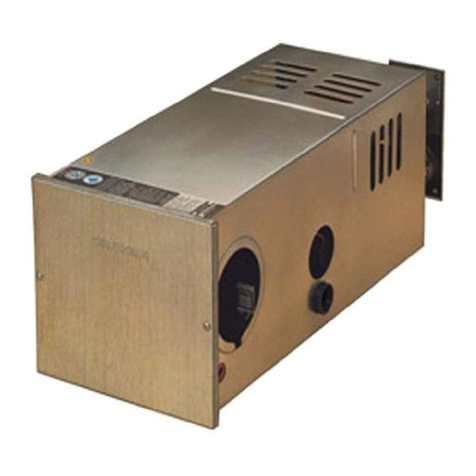
Suburban
Suburban NT-12S Service manual

Winchester
Winchester WEFC**48 installation manual
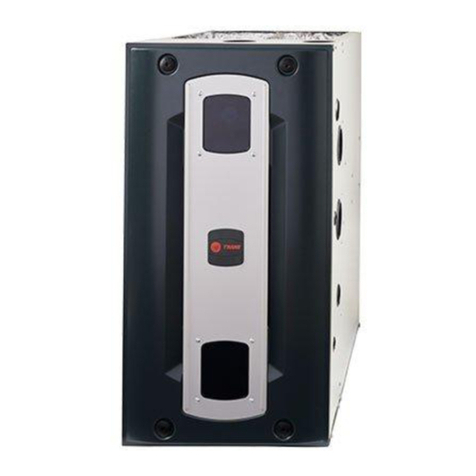
Ingersoll-Rand
Ingersoll-Rand S9V2B040U3PSBC Service facts
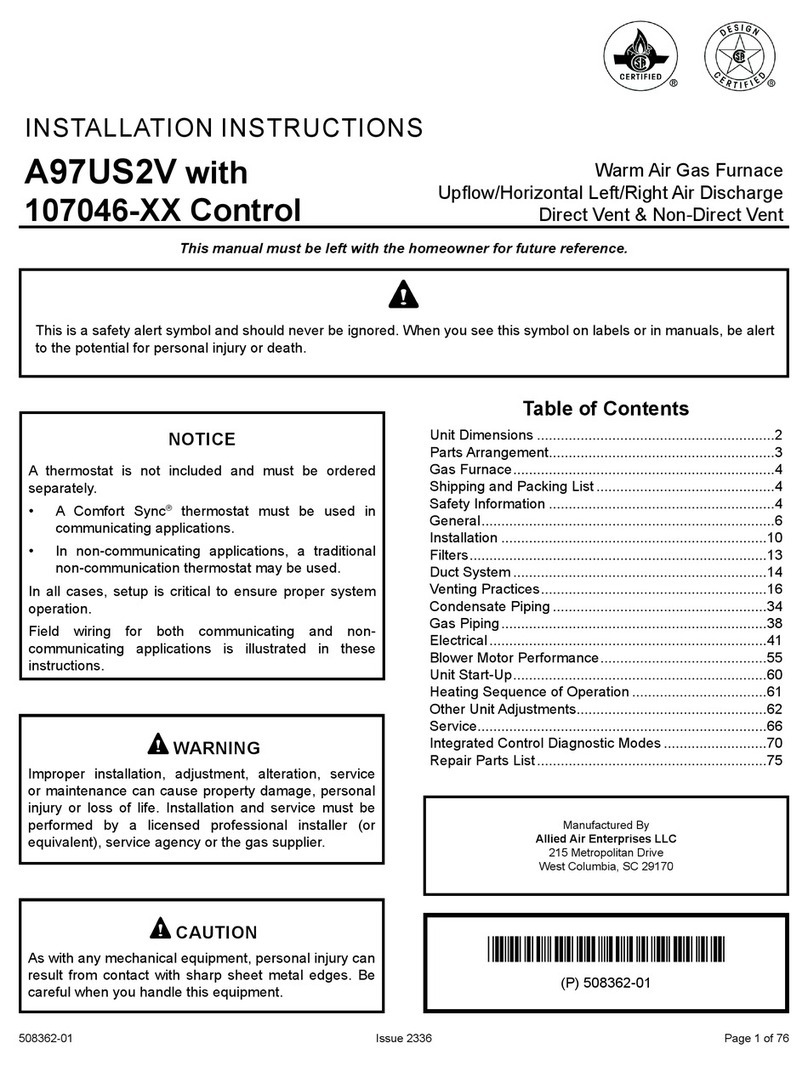
Allied
Allied A97US2V installation instructions
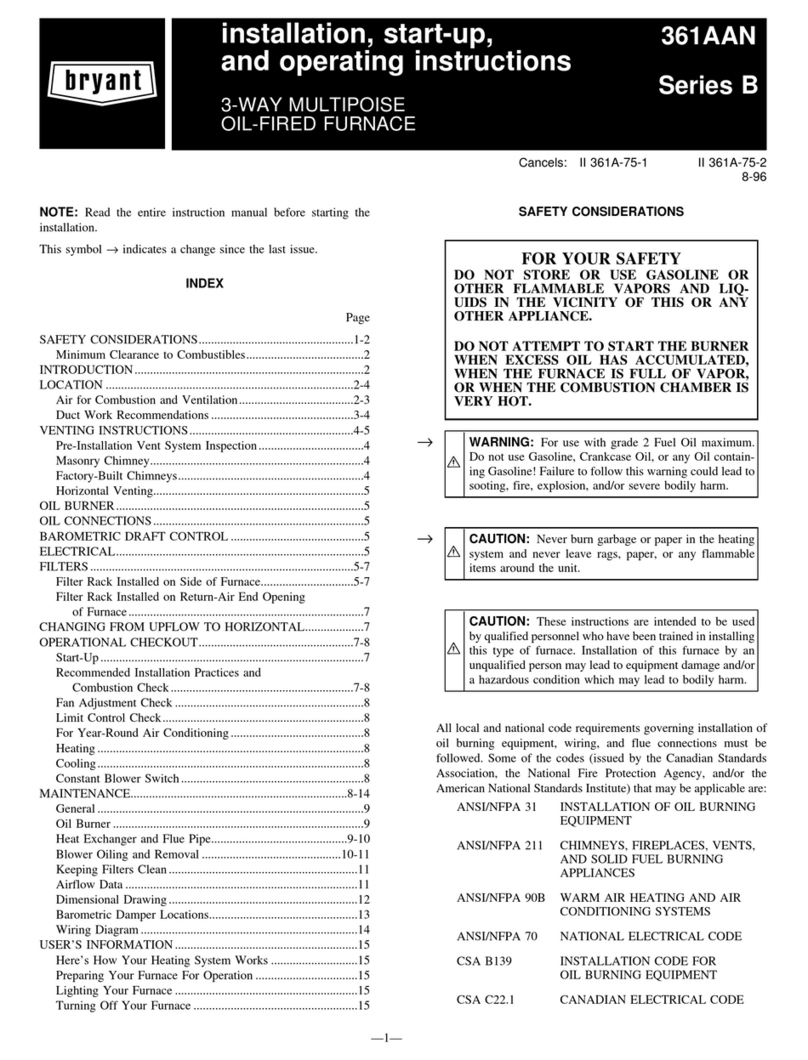
Bryant
Bryant 361AAN Installation, start-up, and operating instructions

Amana
Amana AMS9 installation instructions

International comfort products
International comfort products F9MXE0401410A Service and technical support manual
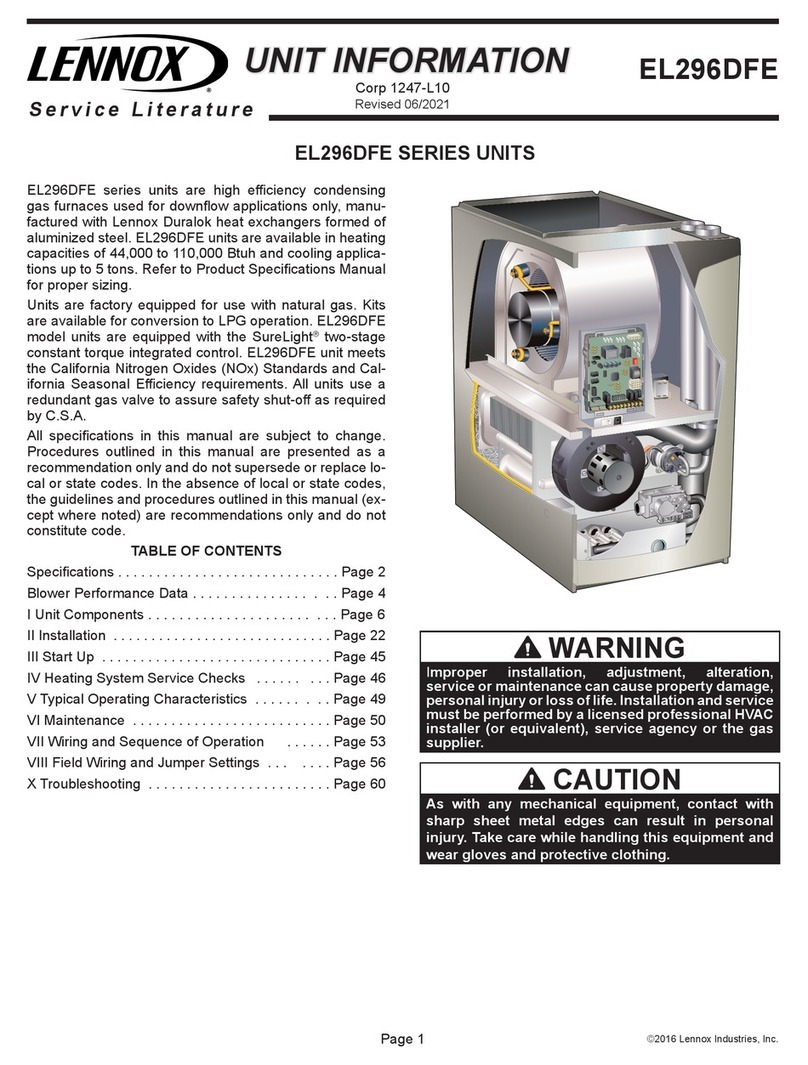
Lennox
Lennox EL296DFE Series manual
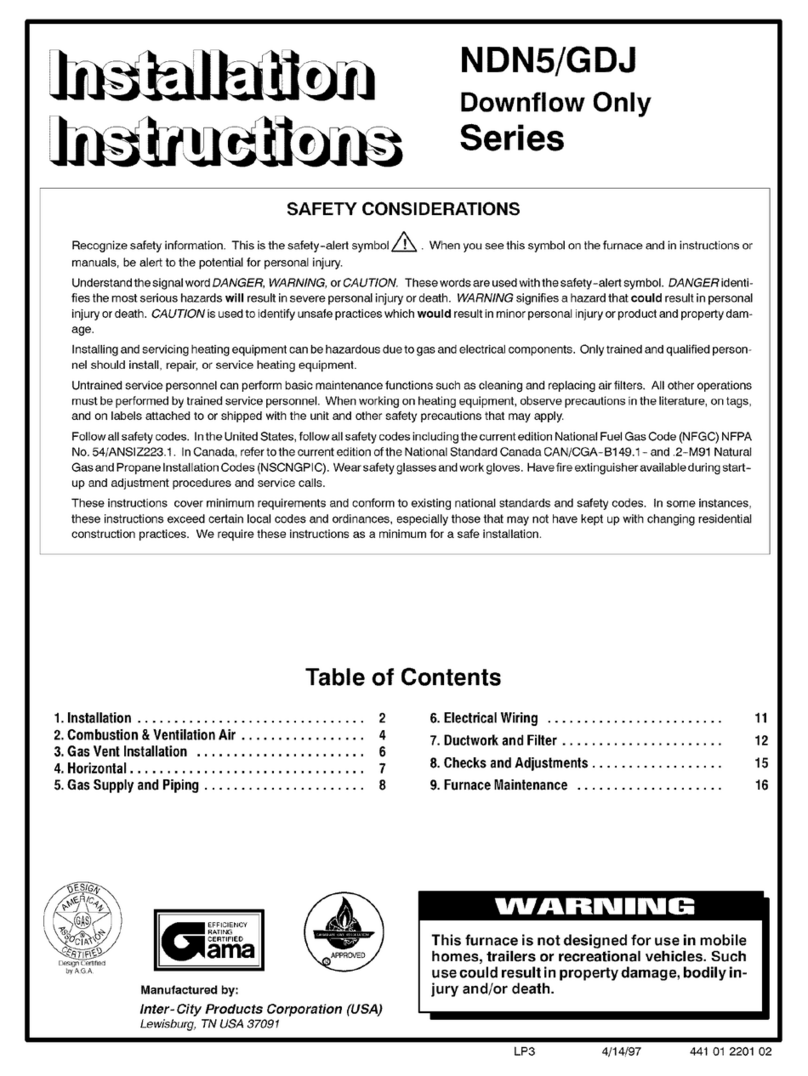
ICP
ICP NDN5050BFA1 installation instructions

Bryant
Bryant A02182 owner's manual
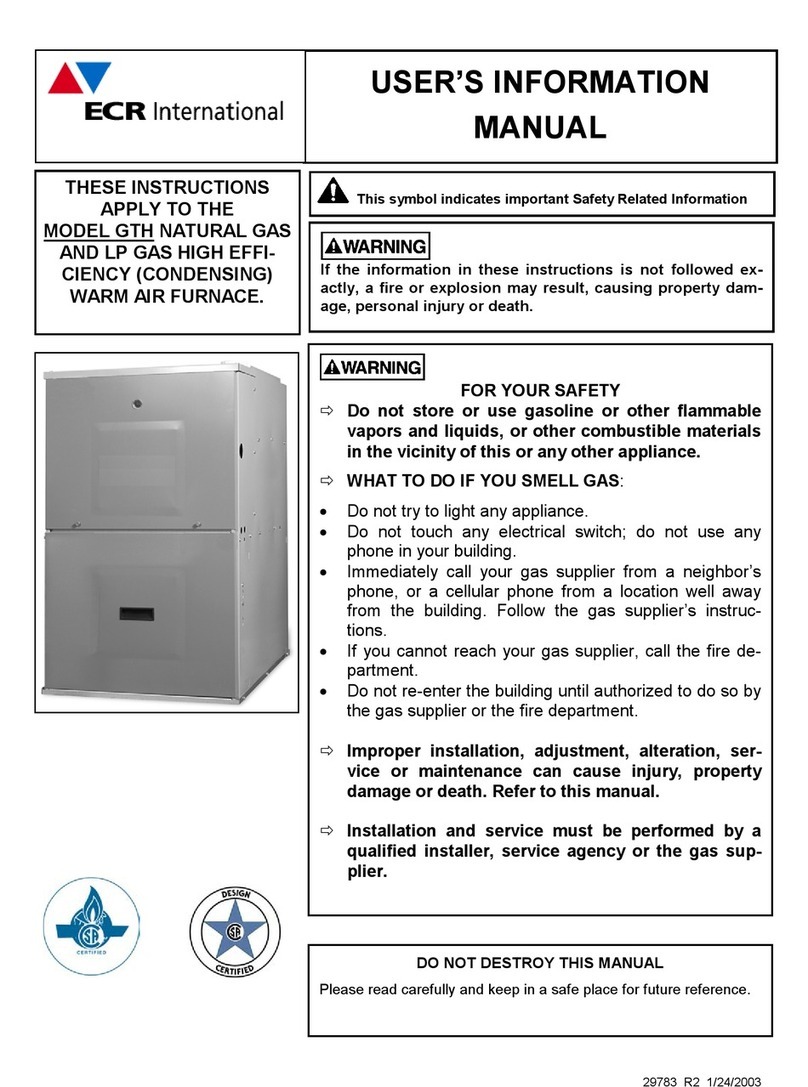
ECR International
ECR International GTH User's information manual
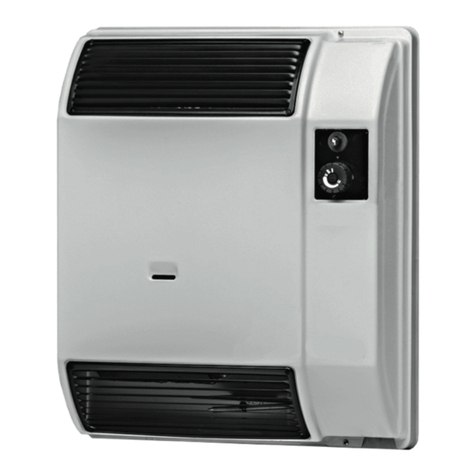
Williams
Williams 0743512 owner's manual
